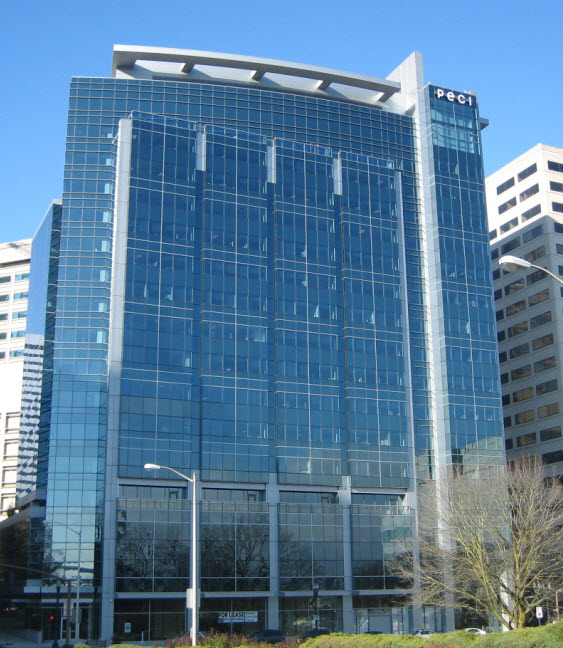New Buildings Institute (NBI) has developed the first ever set of plug load energy use metrics, which will allow commercial building owners and managers to more easily gain insight into their buildings’ energy use and become more energy efficient. Earlier this year, PECI used the NBI metrics to assess plug load energy use at PECI headquarters in the First and Main building in downtown Portland, Oregon. The study, which informed an energy-saving campaign, resulted in an 18 percent kWh reduction of PECI’s plug load.
Review New Buildings Institute Metrics, “Methodology for Reporting Commercial Office Plug Load Energy Use” and PECI case study, “Analyzing Plug Loads.”
According to the Energy Information Agency, plug load – which is defined as electricity use by equipment that plugs into a building’s electrical outlets – is one of the fastest-growing sources of energy use in commercial buildings. In typical offices, 15 to 20 percent of energy use can be attributed to the plug load of computers, monitors, printers, desk lamps, telephones, etc. In buildings with HVAC and/or lighting systems that have been upgraded or improved to be more energy-efficient, plug load can reach as high as 50 percent of total energy use.
The intent of NBI’s new metrics is to set a benchmark for plug load energy use and make it easier for building owners and managers to spot opportunities to improve energy efficiency. The methodology allows an apples-to-apples comparison of plug load energy use across commercial buildings, even if they have vastly different plug load makeups and characteristics.
PECI helped NBI test the theories behind their metrics during a study conducted in the Portland offices of PECI. PECI’s LEED Platinum office is equipped with an energy management system that allows circuit-level monitoring of energy use throughout the office space. This fact, coupled with PECI’s commitment to the study, practice and influence of responsible energy management, made the site – and the pairing – ideal.
NBI’s metrics showed that PECI’s plug load performance during business hours was already quite good, with numbers comparable to the metrics’ lowest reference value. Overnight, however, PECI’s plug load rated more poorly, with values above the metrics’ median.
“We discovered our higher overnight plug load was primarily due to people leaving their computers in ‘sleep mode’ when they left the office for the day,” said Joan Effinger, Engineering Manager at PECI. “We were excited to use the findings as an opportunity to improve.” PECI launched an internal campaign to motivate people to completely shut off their computers at the end of the day, which contributed to an 18 percent kWh reduction of plug load.
“It was very valuable to conduct such a successful test in a real-world situation,” said Cathy Higgins, Research Director of NBI. “Hopefully this is the first of many cases when people use these new metrics to improve the performance of buildings and reduce energy and cost.”
[1] Plug loads are a part of what is known as Miscellaneous Electrical Loads (MELS)
About PECI
PECI is a nonprofit corporation dedicated to creating the new energy economy. We are leaders in the field of energy resource management, with expertise in designing and implementing energy efficiency programs for utility and government agency clients. Our work helps millions of residential, commercial and industrial utility customers reliably save energy and money. We were founded in 1979 in Portland, Oregon and currently work with clients nationwide. To learn more, visit www.peci.org.
About NBI
Established in 1997, New Buildings Institute (NBI) has been a driving force in advancing energy code stringency, most notably with the adoption of the 2012 International Energy Conservation Code (IECC), which was based largely on NBI's Core Performance Guide--a prescriptive approach to high performance commercial buildings. The organization also advocates for measuring building energy performance in occupancy rather than relying on modeled predictions to assess efficiency levels, and has become a clearinghouse on zero-net energy policies and practices. To learn more about NBI go towww.newbuildings.org or call 360.567.0950.
Related Stories
| Aug 11, 2010
Great Solutions: Healthcare
11. Operating Room-Integrated MRI will Help Neurosurgeons Get it Right the First Time A major limitation of traditional brain cancer surgery is the lack of scanning capability in the operating room. Neurosurgeons do their best to visually identify and remove the cancerous tissue, but only an MRI scan will confirm if the operation was a complete success or not.
| Aug 11, 2010
Great Solutions: Collaboration
9. HOK Takes Videoconferencing to A New Level with its Advanced Collaboration Rooms To help foster collaboration among its 2,212 employees while cutting travel time, expenses, and carbon emissions traveling between its 24 office locations, HOK is fitting out its major offices with prototype videoconferencing rooms that are like no other in the U.
| Aug 11, 2010
2009 Judging Panel
A Matthew H. Johnson, PE Associate Principal Simpson Gumpertz & HegerWaltham, Mass. B K. Nam Shiu, SE, PEVP Walker Restoration Consultants Elgin, Ill. C David P. Callan, PE, CEM, LEED APSVPEnvironmental Systems DesignChicago D Ken Osmun, PA, DBIA, LEED AP Group President, ConstructionWight & Company Darien, Ill.
| Aug 11, 2010
Inspiring Offices: Office Design That Drives Creativity
Office design has always been linked to productivity—how many workers can be reasonably squeezed into a given space—but why isn’t it more frequently linked to creativity? “In general, I don’t think enough people link the design of space to business outcome,” says Janice Linster, partner with the Minneapolis design firm Studio Hive.
| Aug 11, 2010
BIM school, green school: California's newest high-performance school
Nestled deep in the Napa Valley, the city of American Canyon is one of a number of new communities in Northern California that have experienced tremendous growth in the last five years. Located 42 miles northeast of San Francisco, American Canyon had a population of just over 9,000 in 2000; by 2008, that figure stood at 15,276, with 28% of the population under age 18.







